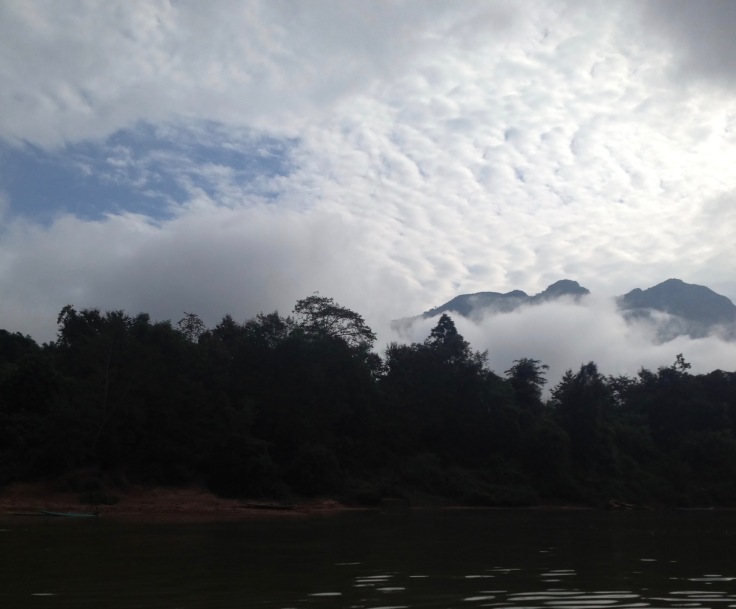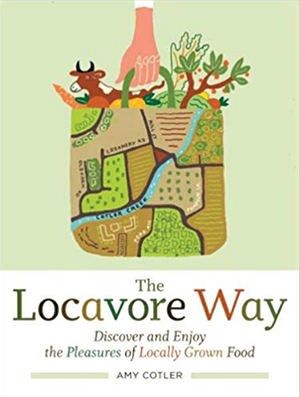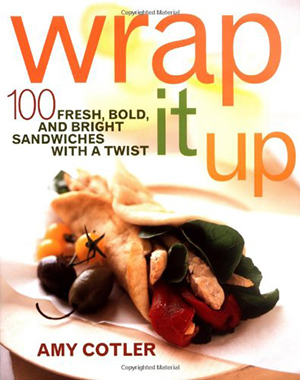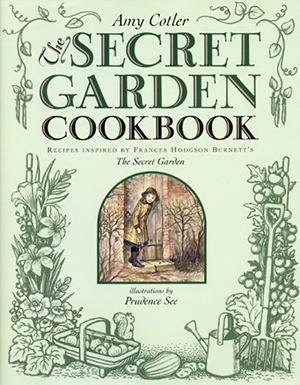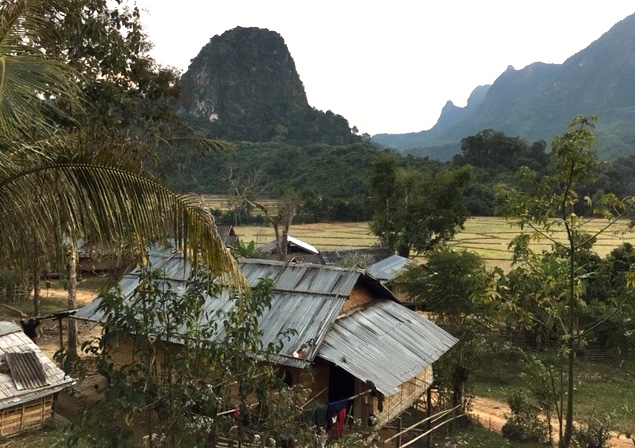

BaNa
Can’t get more farmed-foraged-and-fished than our meal of river fish with garden dill and a squeeze of lime picked from the tree out back. Light and fresh, we ate them whole, heads and all, from their bamboo infused broth, their bones crunching ever- so-slightly in our mouths.
Our Lao friend Ticky’s classic Lao Joew sauce sat in its bowl awaiting. So we balled up our sticky rice, plunging it into this dark mixture, which was sour from the hog plum he picked on our walk to the farm. After simmering it up, seasoning it with chilies and fish sauce, only its large pit remained, taking up most of the small dipping bowl.

That Southeast Asia flavor dance really boogies in your mouth: sour fruit, salty fish sauce, hot chilies. Weeks later I still yearn for this ambrosia.

From the table, we could see out over the harvested rice field, where there is constant, albeit slow movement. A few cows idle in the brown and green farmscape. Brown from the short cut rice stalks from the last harvest, green from the vegetable garden, but mostly from mountainous forests and jungles beyond.
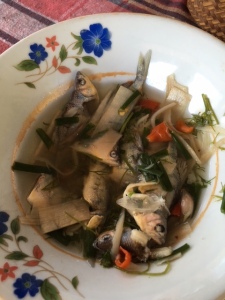
Two boars the size of small dogs follow each other, one coated with mud. Chickens peck the harvested rice fields for leftovers. Roosters and oodles of ducks strut and waddle. Water buffalo graze in the distance. A few look unnaturally white, one with a pink blush. They’re what Ticky calls farang buffalo. Farang, as in foreigner, he explains, throwing his head back, his body shaking with laughter.
And when it’s night, all these animals wander home to a traditional bamboo home, which stands high on wood trunks to house them. There, they’re fed, though not too much. So, come daybreak, they will go out once more, still hungry, to forage for food.
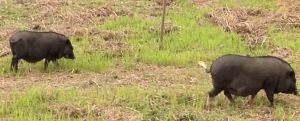
Morning and Night
When I woke up in the early morning the smoke had already begun to cloud the air behind me, as I know it does all over Laos. Morning smoke, and evening smoke too, to signal cooking will begin again. At both times, and in all the small towns, always dogs. Often in single tones of beige, black and brown, napping by these fires, especially at night when Judy, Shirley and I wore our layers of fleece to keep off the chill.
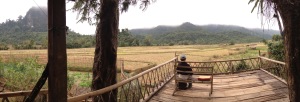
Thin strips of bamboo make ideal kindling for these fires. Bamboo is used for everything else too — to build houses for shelter, to cut bamboo shoot shavings into our morning soup. Even in death, bamboo coffins.
In the early morning, I left our bamboo room, where we slept three across, covered in a teepee of mosquito netting. I walked by “Grandpa”, a lean man about my age. sabaidee, sabaidee, we greet each other. He poked the fire to spark a bigger flame for warmth and lit a cigarette.
I made my way to the outhouse, but someone had beat me to it, ‘cause there was a splat of crap on the floor. In the early morning light, I saw a large white duck, his webbed feet straddling the hole that was my toilet. His head was tipped forward and he was drinking out of the bowl. (More below these pictures and video.)
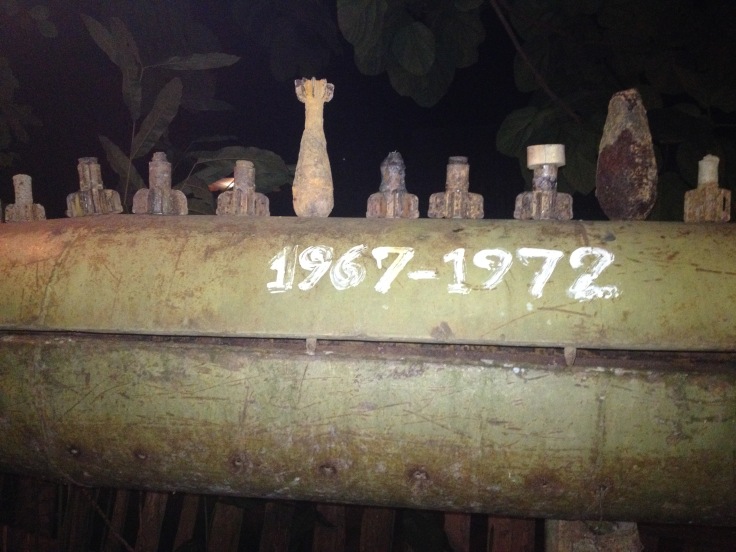
The War, The World
I lay looking out on the farm in a hammock made of knotted camouflage material. Sure it was frayed, but could it be from a war so long ago? Between 1964-73 two million tons of bombs were dropped on Laos. That’s one planeload every eight minutes, 24 hours a day, for nine years — more than was dropped on Germany and Japan during World War II. Experts estimate that about 30%, over 80 million small cluster bombs, remain unexploded.
On our walk back to Muang Ngoi, Ticky motioned to the mountains ahead. Behind us lay a rural school where the children squatted over low fires, cooking their meals. Ticky’s finger pointed up high to areas of ragged rock. Damage, he tells us, from dropping bombs.
As a boy, during the war, Dad and his family hid in caves by day when it rained bombs. By night they harvested sticky rice to live on.
Years passed, and the world turned again.
In the 90’s Ticky’s Khmu family, along with thousands of hill tribe people, were relocated by their communist Lao government from the mountains to the lowlands. (Forced relocation is hardly new to Laos or to Southeast Asia). The policy’s purpose, I have read, is in part to protect the mountainsides from the traditional slash and burn agriculture.
Unlike lowland rice, sticky rice — yes, it’s very sticky — is grown in steep mountainous regions. After annual harvesting, the remains are burned off, and the land can’t be reused for five years. Today region is being is heavily mined for its natural resources, many say by the Chinese. We saw huge mining bases and trucks filled with hardwood traveling the roads.
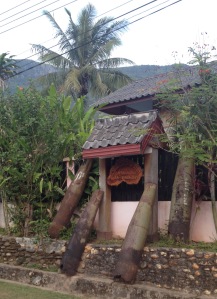
Moving the huge ethnic population was supposed to provide infrastructure, including education and healthcare in the lowlands. (And it is true that it wasn’t an easy life in the mountains. Four of Ticky’s siblings died young, 2 of malaria. All the more reason to eat the bat meat that Ticky was fed as an infant, so he could fly away.)
I have read that the government hopes to consolidate the population, exerting more administrative control than is possible in sparse rural communities, while integrating ethnic minorities into the general population. (And marching Laos forward towards a modernized market-driving state.)
As an outsider, I won’t say. Once my research began, the rabbit hole grew deeper. There is no question that ethnic minorities, who have been stripped of their traditional means of livelihood, are poorer than the general populous. Healthcare and education is limited. Meanwhile Ticky’s family (and so many others), who farmed the mountains for generations, have had to find a different way to earn their living in the lowlands in the new villages were they live, often quite meagerly.
If asked about the changes they’ve have seen, the Lao might might use an expression I’ve heard often here. It seems to accompany a shrug, “Same, same, different.” (More of this post after the pictures and video below.)
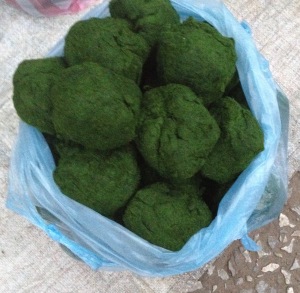
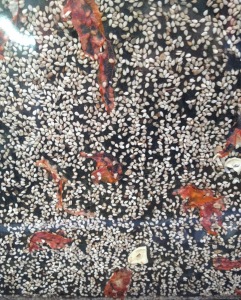
On our walk back to Muang Ngoi, we passed the Tham Kang cave. Across from it was the waterwheel I wrote about in the last post about this trip. The waterpower is used to break the hull off the rice, turning it from brown to white rice. (More below this video)
[wpvideo AAaMxO2P align=”alignright” w=300 h=460]
Up River from Muang Ngoi
We wandered up through a few villages, then walked back from BaNa to our home base in Muang Ngoi (see last post), where we took a day trip up river. I was jubilating to the tut-tut of the engine, the surrounding riverbanks with their family gardens, and the mountains beyond, when 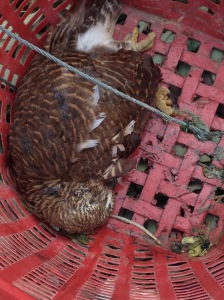 suddenly we stopped. Excited, Ticky pulled a dead bird out of the water. Impaled on the fish net, he claimed it had committed suicide, and giggled excitedly, “I haven’t had owl in 10 years.”
suddenly we stopped. Excited, Ticky pulled a dead bird out of the water. Impaled on the fish net, he claimed it had committed suicide, and giggled excitedly, “I haven’t had owl in 10 years.”
Soon afterwards, we docked, feathers flying everywhere as the two men plucked the bird, lit the fire. We sat on our stone beach by the clear river, eating a picnic of owl, skewered little fish with pickled greens and Ticky’s Jeow and sticky rice, brought from town. The owl tasted of fresh wild bird, gamey and rich. A meal tastes so much better eaten in context.

That night, Ticky conjured up dinner from the family of the boat owner. He killed a chicken just for us, which we had, of course, with sticky rice. The bird was all skin and bones, more sinew and meat from more exercise than food. But we felt like honored guests, sitting with Ticky and his new friends, the boatmen and his wife, who spoke no English. She smiled on us with her flat smooth face glowing in the firelight, her young son running in and out.
And Judy, Shirley and I shared the evening with Ticky and this family in the front of their home, looking out onto the hard-packed dirt street, the main drag in town, where everyone was sitting by their own fires, no doubt, eating their simple meals of not much, together.
Traveler’s tips
I generally travel independently. But in Northern Laos, if you can, travel with a Lao friend. Ticky, infused our trip with meaning. He answered my endless questions, while serving as our interpreter, negotiator, window into Lao culture. He helped us crack the surface, which is especially important in Laos, because the Lao, with the notable exception of Ticky, can be quite shy with strangers. Besides, I got to drink the clear, potent Lao Lao in Laos! (Happy to put you in touch with Ticky if you like. Just write to me in comments.)
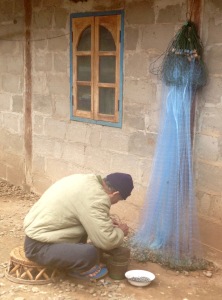
Getting there. Local Minibus from Luang Prabang to NongKhiew cost about 55000 Kip/ 7 $, and it took around 3 hours. The cost of boat is 25000 Kip/ 3 $ and runs 2 times per day at 11:30 AM the last one at 2:00 PM, and it takes about 1-1/2 hours and 1 hour back. We stayed at the guesthouse in Muang Ngoi guest house called Saylom, which cost us 50,000 Kip/ 6$ for a single and double room 80,000 Kip /10$ Name of the guesthouse in BaNA Called Chanthanom and cost 50,000 Kip/6 $. The friendly owner, Mr. Keo, speaks French. Right next door there’s a restaurant with a good view of the river.

